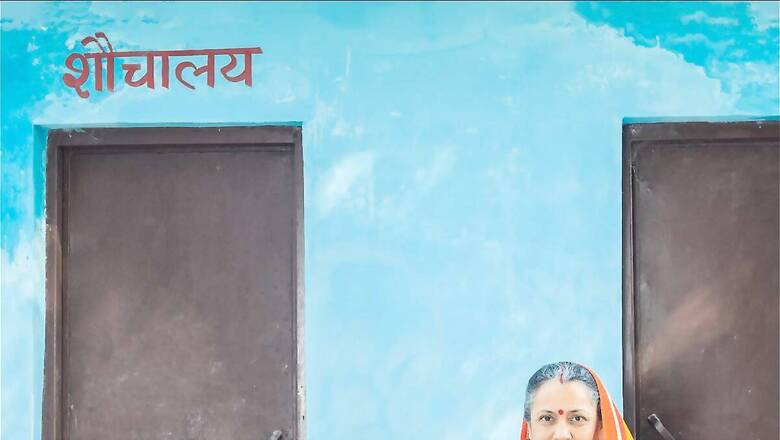
views
Imagine if you lived in a house without a toilet. If you had to use a community toilet, that is situated at a distance, and you need to walk down a road that is not well lit, to get to it.
Or let’s imagine that you do have access to a private toilet, but it isn’t clean, and you don’t know what you don’t know about toilet hygiene. How would this affect you? While it would be a problem for men and women both, there is a stark difference in the level and type of difficulties faced by each.
By and large, the responsibility of toilet hygiene falls on the shoulders of women, irrespective of their education level. This is a fact that India’s leading lavatory care brand, Harpic, is well aware of. Over the years, Harpic has led several campaigns that address toilet hygiene and the various small steps that families can take to ensure that their family toilets are, indeed, safe.
How women vs men experience Safety without toilets
For women, the first thing that is threatened is their sense of safety. It doesn’t feel safe to go to the fields: you can’t go in the daytime because people can see you. In the nighttime, there’s always the risk that one might step on a poisonous insect or reptile, or be set upon by a larger predator.
For women who have access to public toilets, the trouble comes from different quarters. Women often restrict themselves to early morning hours, as that is when these facilities are more likely to be clean. They also tend to go in groups, making them less vulnerable to sexual violence and attack. However, should a woman miss that early morning call, going to the toilet can feel fraught with risk.
For men who don’t have access to toilets, they too face the dangers of poisonous insects and larger predators. However these are often mediated by going to the toilet in the daytime, when the bright light of day keeps such creatures away. For those who use community toilets, the risks of sexual violence and attack are far lower.
How women vs men experience Health without toilets
The health consequences of the lack of access to toilets for women are significant, particularly during pregnancy and childbirth. Without proper sanitation facilities, women are at risk of contracting infections and diseases that can have serious implications for their health and the health of their children. According to the World Health Organization (WHO), approximately 830 women die every day from preventable causes related to pregnancy and childbirth. A lack of access to proper toilet sanitation facilities is a contributing factor to these deaths. Women who do not have access to toilets are more likely to develop infections and diseases, such as urinary tract infections, which can lead to more serious conditions, including sepsis.
Women who use community bathrooms also tend to ‘hold it’ more often, putting unnecessary strain on their internal organs. They also tend to hydrate less, to minimise trips to the toilet. Moreover, during their menses, women are far more susceptible to infections caught in dirty toilets. In general, it is much easier for women to catch urinary tract infections from dirty toilets because a woman’s urethra (the tube from the bladder to where the urine comes out of the body) is shorter than a man’s. This makes it easier for bacteria to get into the bladder.
For men who have no access to toilets or access to community toilets only – the risks for UTIs remain, but to a lesser degree. For men who tend to ‘hold it’, kidney problems can occur.
How women vs men experience Dignity without toilets
For women, the lack of access to toilets can be a significant barrier to maintaining their privacy and dignity. In India, menstruation is considered taboo, and women often feel ashamed or embarrassed when male members of their family realise that they are menstruating. For women who don’t have access to toilets at all, this creates a no win situation: there is no safe place to change their sanitary napkins or cloth, no place to dispose/wash them without prying eyes, and nowhere to hide, if you’ve stained your clothes.
For women who use communal toilets, the issue stems from the lack of cleanliness. A dirty toilet can almost guarantee infections for a menstruating woman.
For men, this is a non issue.
The life changing toilet
In the past 5-8 years, India has made great strides in making toilets available to everyone. Under the Swachh Bharat Mission, millions of toilets were constructed all over the country ensuring that no Indian is left behind. Women, in particular, have appreciated the convenience of toilets, the safety and the privacy they bring. They’ve also seen firsthand the impact of healthier toilet habits on the health of their families – children don’t get sick as often, or as severely. They also miss less school.
However, not all areas with toilets report the same uptake. There are two sides to the problem of sanitation: access to toilets and the behavioural change needed to make their use a norm. Unfortunately, behavioural change has happened at a pace slower than the pace at which these toilets were constructed. In many parts of the country, there is still resistance towards using these toilets, and particularly, in bearing the responsibility of keeping them clean.
The Sub-Group of Chief Ministers on Swachh Bharat Abhiyaan maintains that behavioural change is an area of continued focus, and has made several recommendations on how to bring about this shift in mindsets. The foremost in these recommendations are education strategies that include inculcating sanitation practices and good toilet habits in children by including a chapter in school curriculum; and the establishment of ‘Swachhata Senani’ students, to spread awareness about toilet sanitation and cleanliness.
The Sub Group report found that younger people are more accepting of toilets, and are helping drive behavioural change within their families. In fact, most children who grow up with toilets, never go back to the earlier ways.
Fortunately, the GoI are not the only ones carrying the mantle of this communication. Harpic, the leading brand in the lavatory care category, decided to take the lead in the sanitation and hygiene movement by creating innovative, thought provoking campaigns and outreach programs. They partnered with Sesame Workshop India, an educational non-profit working for the early developmental needs of young children, to promote positive sanitation, hygiene knowledge and toilet behaviours among children and families through schools and communities, engaging with 17.5 million children across India. The programme aims to raise awareness and reinforce healthy toilet and bathroom habits among young children, developing and recognising them as “Swachhta Champions”.
Harpic has partnered with News18 for Mission Swachhta aur Paani initiative since its inception 3 years ago. It is a movement that upholds the cause of inclusive sanitation where everyone has access to clean toilets. Mission Swachhta aur Paani advocates equality for all genders, abilities, castes and classes and strongly believes that clean toilets are a shared responsibility.
To mark the occasion of World Health Day on April 7th, Mission Swachhta aur Paani are bringing together policy makers, activists, actors, celebrities and thought leaders with a panel from News18 and Reckitt’s leadership to address behavioural change on toilet use and sanitation, and how people from all walks of life can help further the cause.
The event will feature a keynote address by Reckitt leadership, interactive Q&A sessions, and panel discussions. The speakers include Union Minister of Health & Family Welfare, Shri Mansukh Mandaviya, Deputy CM of Uttar Pradesh, Shri Brajesh Pathak, Director of External Affairs & Partnerships, SOA, Reckitt, Ravi Bhatnagar, UP Governor Anandiben Patel, actors Shilpa Shetty and Kajal Aggarwal, Regional Marketing Director of Hygiene, Reckitt South Asia, Saurabh Jain, sportsperson Sania Mirza and Padma Shri S. Damodaran, Founder of Gramalaya, among others. The event will also feature on-ground activations in Varanasi, including a visit to Primary School Naruar and a ‘Chaupal’ interaction with sanitation heroes and volunteers.
To know more about how you can play a part in this national conversation, join us here. A Swachh Bharat and a Swasth Bharat is within our reach, with a little help from you.
Read all the Latest News here



















Comments
0 comment